War seemed like a distant possibility to most Americans, with battles fought by other countries in far-off, foreign-sounding places, until Japan's surprise attack on Pearl Harbor on December 7, 1941. As millions of young men mobilized for war, those on the home front began to experience sweeping changes that would dramatically impact daily life. "Remember Pearl Harbor!" became a rallying cry as the country pulled together in an unprecedented display of patriotism to win the war and preserve precious freedoms.
The Minnesota Office of Civilian Defense recruited Wardens to patrol neighborhoods and help to prepare citizens for possible enemy attack. The Wardens oversaw blackout and air raid drills, instructed the public on emergency procedures in the event of a gas attack, helped people to plan Victory Gardens, promoted nutrition and physical fitness as weapons of war, handled emergency manpower needs, and provided information about rationing.
As military demand for food and materials grew, shortages in the land of plenty became a way of life. Rationing on foodstuffs was first imposed in 1942, closely followed by shoes, rubber, gasoline, and other non-food commodities. Each member of every family received a ration book, which dictated how much of a given commodity could be purchased, and the number of ration stamps or tokens required. Americans of all ages salvaged paper, cooking fats and rubber, and participated in scrap drives for aluminum, tin, and other metals that could be recycled into war materiel. Families planted large Victory Gardens to supply their tables with homegrown fruits and vegetables to supplement rations.
As more and more men entered the armed forces, the face of the American workforce also changed. Encouraged by the War Manpower Commission's propaganda and lured by good wages, women began to take on job responsibilities in business and industry that had been closed to them in peacetime. Many took jobs in shipyards and defense plants, helping to produce battleships, aircraft, vehicles, weapons, ammunition, and other items needed for the war effort, and "Rosie the Riveter" became an iconic image of wartime propaganda. Others helped out in the private sector, taking on such jobs as streetcar "motorettes," factory workers, and farm laborers.
Bond drives – advertised as "War" bonds, then "Victory" bonds – offered Americans a way to save money while actively supporting the war effort. Wage earners could purchase them through payroll deduction at work, and even children put their pennies toward bonds at school by buying war savings stamps.
Families gathered around radios to listen to the latest news from the fronts. Those with loved ones serving abroad wrote volumes of letters, and proudly displayed service flags in the windows of their homes, all the while dreading the delivery of a War Department telegram that would turn the flag's blue stars to gold.
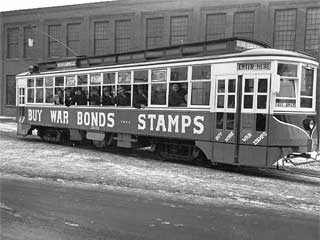
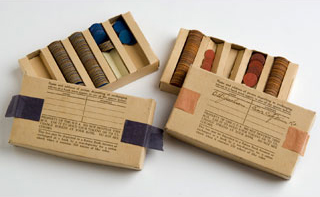

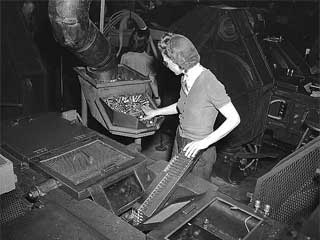
Rosie The Riveter
As parents were using their ingenuity to guide their families safely through the dark days of the Great Depression, their children were creating their own fun.
Those that could afford the dime admission, like William M. Cummings and Robert and George McKewin, flocked to movie theatres to be swept away by such adventures as King Kong, The Moon Riders, and The Wizard of Oz. Many children huddled around the family’s radio to listen to the adventures of Tom Mix, Buck Rogers, and Jack Armstrong, the All-American Boy.
Children found a similar escape in reading, enjoying books and the "funnies" in the newspaper. Popular board games, such as Lexico (1931 - later Scrabble®), and Parker Brothers’ newly invented Monopoly® game (1935), offered other stay-at-home activities for children. Both boys and girls participated in outdoor games and played sandlot baseball and other sports, often substituting makeshift equipment, like sticks and stones, for real bats and balls and, like Robert D. Hill and Dorothy Snell Curtis, making the most of Minnesota winters.
For the poor, homemade toys, such as cars, dolls and puppets, were cherished gifts, as were recycled toys – used toys that had been repaired by volunteers from charitable organizations.
Though holidays were not as festive as they might have been in better times, children still looked forward to celebrating Halloween, Christmas, and other festival days.
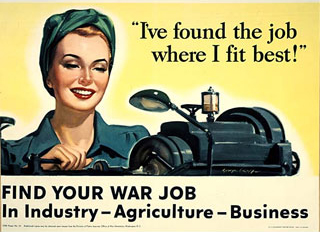
We're All In This Together!
The "Roaring Twenties " call to mind a modern, prosperous, yet controversial decade. Expendable income was on the rise, and more consumer goods than ever before became available. But the good times would not last.
The confidence and feeling of security enjoyed by many American families, like that of Robert D. Hill, evaporated following the market crash of October 29, 1929, when the financial rug was pulled out from under them. Millions of breadwinners, like the fathers of Mary Joy Breton and Michael Sanchelli, found themselves out of work. Faced with the greatest deprivation many would ever know, families struggled to make ends meet. Very few families were unaffected by the Great Depression .
The children of the Great Depression learned of necessity to be resourceful, wearing hand-me-down clothing, going without luxuries of any kind and, at times, going without meals.
Many young men joined the Government's Civilian Conservation Corps, which promised temporary employment and steady wages, and even young children, found work in an attempt to make a financial contribution to their families -- in some cases giving up educational opportunities to do so.
Children learned the value of a dollar and how to save, lessons that would stay with them throughout their lives and that would be reflected in frugal and careful habits: darning socks and patching play clothes for their baby boom children, scraping the inside of an egg shell to get every last bit of egg white, clipping coupons and saving Gold Bond trading stamps.

"Mail Call, Soldier!"
Members of Minnesota's Greatest Generation generally share a strong work ethic. Many boys held jobs working as farm help, newsboys, pinsetters in bowling alleys, and messengers, while their sisters helped out in more domestic capacities at home or as hired help.
Some children, like Michael T. Sanchelli, were self-employed, searching junkyards for castoffs that could be sold. While many children who sought employment during the Great Depression, like Robert D. Hill, did so to make a much-needed financial contribution to their families, others, like William M. Cummings, worked to earn spending money. Rural children, like Mary Joy Dean, helped out on the farm, working without pay.
These young workers benefited from the efforts of the National Child Labor Committee, whose work in the 1910s and 1920s resulted in protective child labor laws. These laws mandated age limits, types of jobs appropriate to children of different ages, and the number of hours per week a child could be expected to work. Children under 16 years of age were allowed to work only during the daytime, with a maximum of an 8-hour workday and a 48-hour workweek.
By 1930, 7.8% of Minnesota's children aged 10 to 17 years were "gainfully employed," with 11.3% of all boys and 4.2% of all girls in that age group employed. The vast majority of boys and girls worked as farm laborers, many as unpaid help on family farms. Urban boys commonly held jobs as factory operatives or newsboys, or were apprenticed to learn a trade. Girls typically worked in factories or as domestic servants in private homes.
Laws also mandated that all children ages 7 to 16 (except for those that had completed the 8th grade) must attend school during the entire session, which averaged 180.6 days according to the 1920 census, ranking Minnesota 10th in the nation for length of term. Rural students could get exemptions for helping their parents on the farm from April 1st to November 1st.

Citations:
 Artwork: Avenge December 7.
Artwork: Avenge December 7.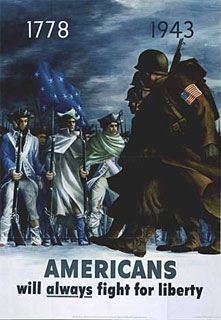 Artwork: Americans will always fight for liberty.
Artwork: Americans will always fight for liberty.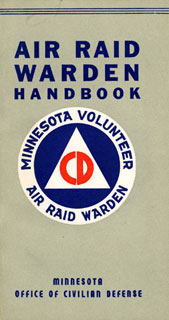 Document: Air Raid Warden Handbook, 1942.
Document: Air Raid Warden Handbook, 1942. Object: Ration tokens.
Object: Ration tokens. Photo: Paper drive, 1944.
Photo: Paper drive, 1944. Artwork: Save waste fats for explosives - take them to your meat dealer.
Artwork: Save waste fats for explosives - take them to your meat dealer. Artwork: Defense needs Rubber.
Artwork: Defense needs Rubber.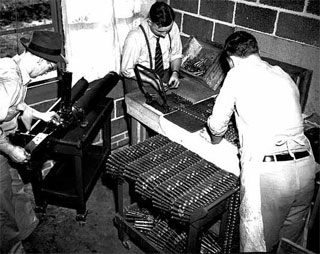 Photo: Manufacturing ammunition, Twin Cities Ordnance Plant, Arden Hills
Photo: Manufacturing ammunition, Twin Cities Ordnance Plant, Arden Hills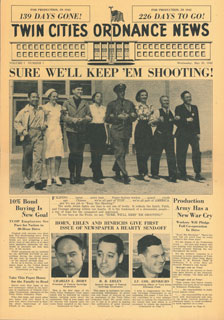 Document: Twin Cities Ordnance News.
Document: Twin Cities Ordnance News.  Artwork: I've found the job where I fit best!
Artwork: I've found the job where I fit best!- Sorensen, Aja, Rosie the Riveter: Women Working During World War II. National Park Service, 2007.
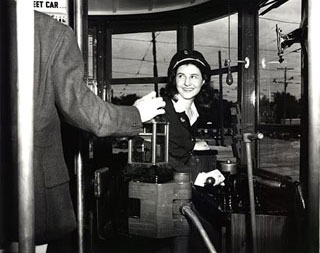 Photo: Streetcar Motorette (first of the female motormen), 1943.
Photo: Streetcar Motorette (first of the female motormen), 1943.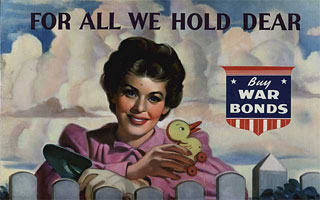 Artwork: For All We Hold Dear - Buy War Bonds.
Artwork: For All We Hold Dear - Buy War Bonds.- War Savings Stamps. Wikipedia.org, 2007.
 Artwork: "What Makes V-Mail Tick."
Artwork: "What Makes V-Mail Tick."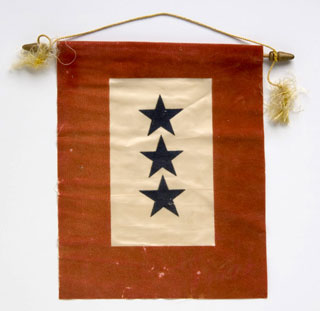 Object: World War II service flag.
Object: World War II service flag. Artwork: Americans Suffer when careless talk kills!
Artwork: Americans Suffer when careless talk kills!
- Kenney, Dave, Minnesota Goes To War: The Home Front during World War II. St. Paul: Minnesota Historical Society Press, 2005.
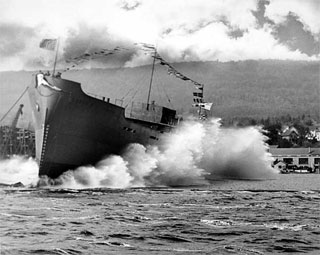 Photo: Launching of the David R. LeCraw, Duluth, 1944.
Photo: Launching of the David R. LeCraw, Duluth, 1944.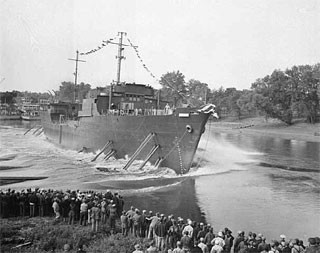 Photo: Launching of the Genesee at Port Cargill, Savage, 1943.
Photo: Launching of the Genesee at Port Cargill, Savage, 1943.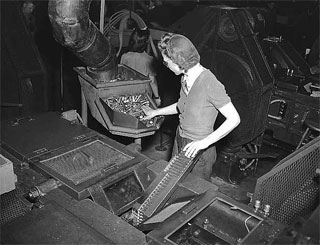 Photo: Manufacturing ammunition, Twin Cities Ordnance Plant, Arden Hills, 1941.
Photo: Manufacturing ammunition, Twin Cities Ordnance Plant, Arden Hills, 1941.- Twin Cities Ordnance News. New Brighton, MN: Federal Cartridge Corp, 1942-. Minnesota Historical Society Newspaper Collection.
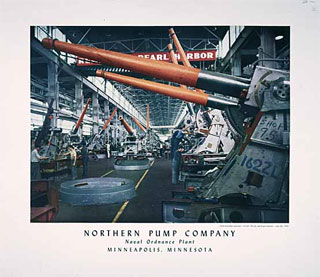 Photo: Northern Pump Company, Naval ordnance Plant, Minneapolis, Minnesota, ca. 1942.
Photo: Northern Pump Company, Naval ordnance Plant, Minneapolis, Minnesota, ca. 1942.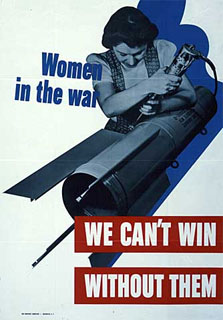 Artwork: Poster: Women in the war - We Can't Win Wihtout Them, 1942.
Artwork: Poster: Women in the war - We Can't Win Wihtout Them, 1942.- Sorensen, Aja, Rosie the Riveter: Women Working During World War II. National Park Service, World War II Home Front National Historical Park, 2009.
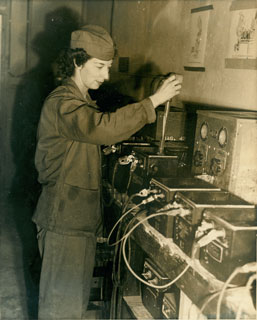 Photo: Ferne Chambers Krans, while serving with the United States Marine Corps, ca. 1943.
Photo: Ferne Chambers Krans, while serving with the United States Marine Corps, ca. 1943.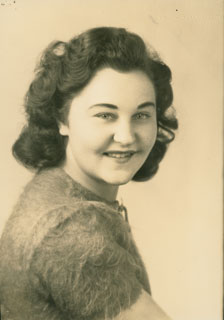 Photo: Kae Eisenreich Vandeputte.
Photo: Kae Eisenreich Vandeputte.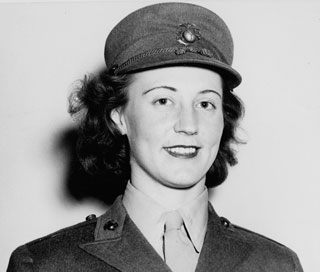 Photo: Martha Kufner Schmaltz.
Photo: Martha Kufner Schmaltz.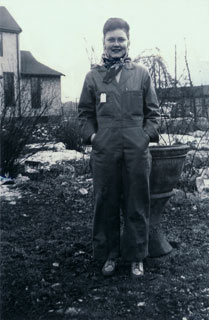 Photo: Millie Bowers Johnson in coveralls, 1943.
Photo: Millie Bowers Johnson in coveralls, 1943.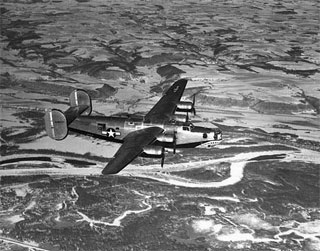 Photo: B-24 modified plane at Holman Field, 1944.
Photo: B-24 modified plane at Holman Field, 1944.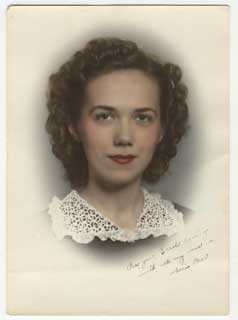 Photo: Doris Shea Strand, 1944.
Photo: Doris Shea Strand, 1944.
- Office of Civilian Defense. Minnesota Historical Society Library Collection.
- Nelson, Dorothy Pederson, Teenage Memories of the Home Front. Minnesota Historical Society: Share Your Story, 2007.
- Nakasone, Edwin; Thomas Saylor, Interviewer, Minnesota's Greatest Generation Oral History Project, Thomas Saylor; Minnesota Historical Society Oral History Collection, 2003.
- Cavanaugh, Marie; Thomas Saylor, Interviewer, Minnesota's Greatest Generation Oral History Project, Thomas Saylor; Minnesota Historical Society Oral History Collection, 2002.
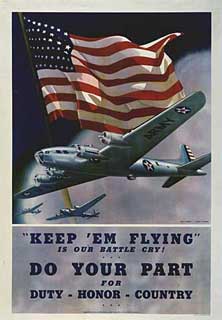 Artwork: "Keep 'Em Flying" Is Our Battle Cry! Do Your Part for Duty-Honor-Country." Loc. no. E448.19 b50
Artwork: "Keep 'Em Flying" Is Our Battle Cry! Do Your Part for Duty-Honor-Country." Loc. no. E448.19 b50
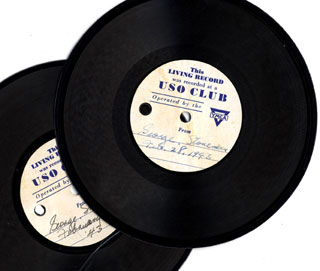 Object: Voice letters recorded by George Snell for his family, 1943.
Object: Voice letters recorded by George Snell for his family, 1943.- Snell, George F., George F. Snell papers, 1930-1949. Minnesota Historical Society Manuscripts Collection.
- V-Mail. Wikipedia.org, 2007.


